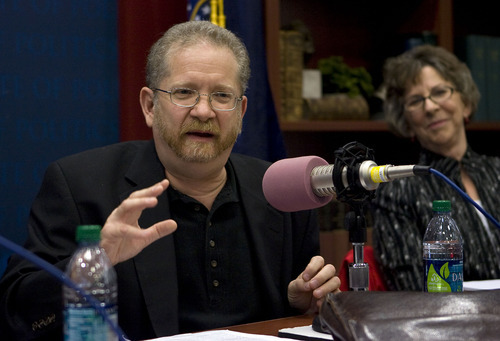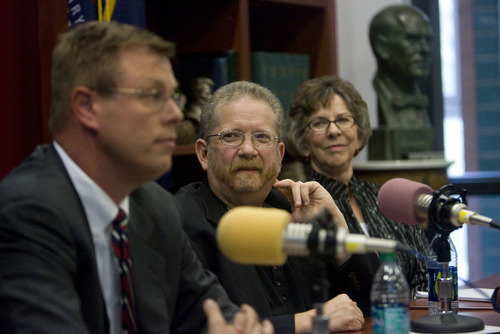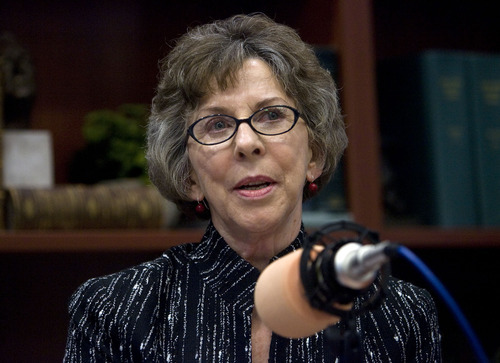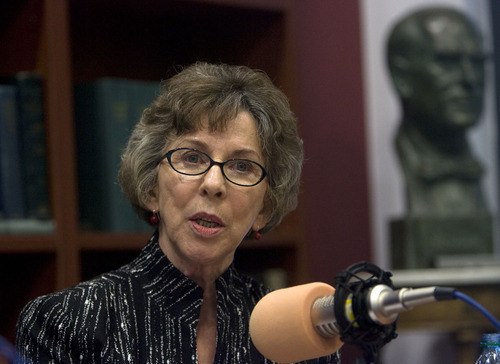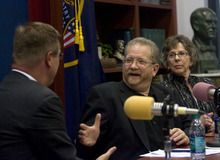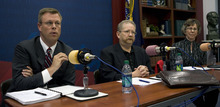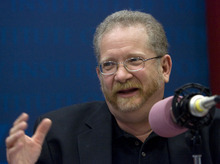This is an archived article that was published on sltrib.com in 2011, and information in the article may be outdated. It is provided only for personal research purposes and may not be reprinted.
Newspaper companies have a curious problem. They have no trouble finding readers for their print and online news content. What they haven't figured out is a sure way to make enough money to support their news-gathering operations.
"The media does not have an audience problem. It has a revenue problem," said Mark Jurkowitz, associate director of the Pew Research Center's Project for Excellence in Journalism.
"The people who are absorbing the content of these news organizations are greater [in number] than ever before, even when newspaper[s] had a circulation that was 25 percent to 30 percent higher. That's absolutely the case. The struggle, obviously, has been how to monetize the online piece,"said Jurkowitz, who spoke Tuesday at a University of Utah forum on the future of newspapers. Salt Lake Tribune Editor Nancy Conway and Clark Gilbert, president and CEO of the Deseret News, also spoke.
For more than a century, newspapers enjoyed a prominence and profitability that allowed them to shrug off inroads made by radio and then television. Lulled by profit margins that often exceeded 20 percent, the newspaper industry failed to acknowledge the threat posed by the Internet and the revolution in digital devices until it was almost too late.
That's changed, Jurkowitz said. Stung by advertising and circulation losses as consumers move online for news, the industry has laid off thousands of reporters and editors, closed newspapers, eliminated bureaus and taken other steps to pinch pennies as they work to develop a new business model to replace the one that had supported newspapers for decades.
Jurkowitz has been traveling the U.S., asking news executives how far along they are in the development of a new model. The answer is not far.
"Everybody understands there is a crisis," he said. "I think people are moving in the direction of experimentation ... There's a lot of activity on pay walls" that permit access to online content for a fee, Jurkowitz said.
"But even within the structure of these corporations, there is an institutional dynamic and there still feels to me like there is something of an internal debate how to proceed," he said, adding that some critics question whether newspapers who were slow to recognize the threat posed by the Internet have the skills to develop innovations that will put the industry back on track. Gilbert has suggested that in the past.
Conway said the industry could have responded sooner to the clouds that were forming over newspapers. But she thinks it is up to the challenges it faces.
"You guys are underselling legacy news providers. I think you underestimate their ability to learn and adapt," Conway said. "I think the newspaper is far from dead. We are not dying. We are actually very healthy and learning to be more nimble and responsive and adaptive."
Through their innovations, Conway said, The Tribune and the News reach virtually every adult reader in the Salt Lake City market. And in the case of The Tribune, that includes younger readers who are more valuable to advertisers.
The debate over the respective futures of The Tribune and the News was displayed during the forum as Gilbert, a former Harvard University business school professor and media wonk, and Conway, who has decades of boots-on-the ground experience editing newspapers, traded competing visions for their rival publications.
Gilbert, who took over the top job at the News last year, has steered the LDS Church-owned paper to focus on six themes that get special emphasis — family, faith, care for the poor, values in the media, financial responsibility and education — standards that church leaders often stress to the membership. Gilbert acknowledged that the content of the News has become more specialized. But he denied that the paper is pushing an LDS agenda. Rather, it has a "voice."
"When we looked at the future of the news industry, we knew there were some things we could not only be the best at in this [Utah] market, but maybe the best in the country," Gilbert said. "And we said we are not only going to be good in that, we are going to invest in that."
Conway said the News has evolved into a "niche" product, a decision she said was both "principled" and "smart."
"If you were to ask me what the most important measure the newspapers took toward their own survival in the past three or four years, I would say it is the Deseret News choosing to become a niche product, to provide the voice of the church in its publication ...a principled one that has the possibility of gaining a worldwide audience," she said.
"I think it was smart. And I think it's very good for The Tribune. It leaves general, everyday journalism to us," Conway said.
Gilbert said the view that values reporting dominates the content of the News is overstated.
"The Deseret News is not writing to just a Mormon audience, but it is writing to a faith and family audience," he said.
Twitter: @SLTribPaul


